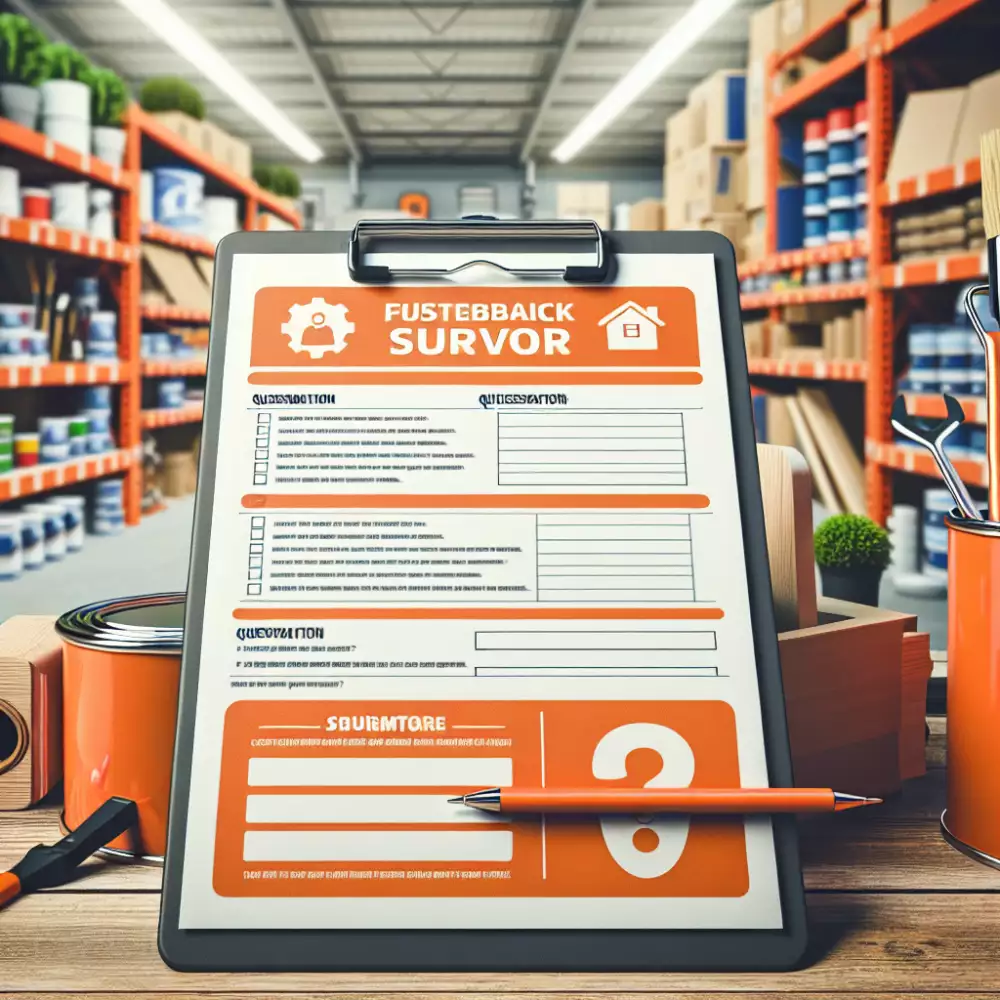Home Depot Survey Reveals Shocking Customer Insights

- Home Depot Business Customer Base
- Importance of Feedback for Businesses
- Survey Participation and Response Rates
- Data Analysis and Interpretation
- Identifying Areas for Improvement
- Enhancing Customer Experience
- Measuring Customer Satisfaction
- Benchmarking Against Competitors
- Tracking Performance Over Time
- Impact on Business Decisions
- Return on Investment (ROI)
- Case Studies of Successful Surveys
- Best Practices for Survey Design
- Future Trends in Customer Surveys
Home Depot Business Customer Base
Home Depot places significant importance on understanding its business customer base, recognizing their distinct needs and preferences. To gain insights into this valuable segment, Home Depot actively seeks feedback through various channels, including dedicated business customer surveys. These surveys provide a platform for businesses to share their experiences, opinions, and suggestions for improvement. The feedback collected through these surveys helps Home Depot tailor its products, services, and overall shopping experience to better meet the unique requirements of its business customers. By listening attentively to business customer feedback, Home Depot can identify areas where it excels and areas that require attention, ultimately strengthening its relationships with this crucial customer segment.
Importance of Feedback for Businesses
Customer feedback is crucial for any business, and The Home Depot understands this well. Their customer satisfaction survey is a prime example of how they gather valuable insights to improve their products, services, and overall customer experience. Through this survey, The Home Depot actively seeks feedback on various aspects, including store cleanliness, product availability, and employee helpfulness. This feedback loop allows them to identify areas where they excel and areas that need improvement.
By analyzing the survey responses, The Home Depot can make data-driven decisions to enhance customer satisfaction. For instance, if feedback indicates that a particular store location consistently receives low ratings for cleanliness, they can address the issue promptly. Similarly, suppose customers express dissatisfaction with the availability of a specific product. In that case, The Home Depot can adjust its inventory management strategies to meet customer demands better.
The Home Depot customer satisfaction survey is a valuable tool for continuous improvement, demonstrating their commitment to listening to their customers and providing the best possible shopping experience.
Survey Participation and Response Rates
Participation in The Home Depot survey is crucial for both customers and the company. By sharing your feedback, you directly contribute to improving products, services, and the overall shopping experience. The Home Depot values your opinions and uses them to make changes that matter to you. While the specific response rates for The Home Depot survey are not publicly available, customer feedback surveys, in general, can experience a wide range of response rates. Factors influencing participation include survey design, ease of access, incentives offered, and the perceived value customers place on providing feedback. The Home Depot recognizes the importance of encouraging participation and may employ various strategies to maximize response rates. These strategies could include sending personalized invitations, offering incentives for completion, and ensuring the survey is mobile-friendly and easy to navigate. By making the survey experience convenient and rewarding, The Home Depot aims to gather valuable insights from a broad customer base.

Your Home Depot experience matters. Share your feedback and help us build a better tomorrow.
Felix Cartwright
Data Analysis and Interpretation
This phase is critical in understanding customer opinions and experiences. Data from the Home Depot survey, gathered through various channels like online forms, in-store feedback kiosks, or mobile app surveys, is meticulously compiled and organized. This often involves categorizing data based on demographics, purchase history, and specific survey questions.
Sophisticated analytical techniques are then applied to identify patterns, trends, and correlations within the dataset. For instance, analyzing responses related to customer service experience might reveal common pain points or areas where Home Depot excels. Statistical tools help quantify satisfaction levels, identify significant drivers of satisfaction or dissatisfaction, and measure the impact of operational changes.
Visualizations, such as charts and graphs, are instrumental in presenting these insights in a clear and understandable manner. These visuals help in identifying key takeaways, such as areas needing improvement, customer preferences, and the effectiveness of implemented solutions. The insights gleaned from this analysis are then translated into actionable strategies.
Identifying Areas for Improvement
Customer feedback surveys are like gold mines for businesses like The Home Depot. They highlight what's working and, more importantly, what needs a little TLC. Maybe the checkout lines are consistently long during peak hours, frustrating shoppers. The survey might reveal that, leading to a revamp of the checkout process or staffing adjustments. Perhaps customers are raving about the helpfulness of the paint department staff. This feedback could prompt additional training programs to replicate that success in other departments. Sometimes, the surveys uncover issues that might otherwise go unnoticed. For instance, customers might point out that the garden center layout is confusing, making it difficult to find specific plants. Armed with this knowledge, The Home Depot can make targeted improvements, ensuring a smoother, more enjoyable shopping experience for everyone. Remember, every piece of feedback, whether positive or negative, is a chance for The Home Depot to learn, grow, and continue to be the go-to destination for all things home improvement.

Enhancing Customer Experience
At The Home Depot, we're always striving to improve and provide the best possible experience for our customers. That's why your feedback is incredibly valuable to us. Whether you recently visited one of our stores or shopped with us online, we encourage you to share your thoughts through our customer satisfaction survey.
Your feedback helps us understand what we're doing well and identify areas where we can enhance our services. This feedback helps us make improvements to various aspects of your shopping experience, from the moment you step into our stores or browse our online aisles to the helpfulness of our associates and the quality of our products.
We want to hear about everything! Tell us what you loved and what could have been better. Your honest feedback helps us train our associates, improve our product selection, and make your next Home Depot experience even better. Look out for an invitation to participate in our survey after your next Home Depot interaction. Your feedback matters, and it's how we build a better Home Depot for everyone.
Measuring Customer Satisfaction
Measuring customer satisfaction is crucial for any business, and The Home Depot understands this well. They actively seek feedback from customers through their survey to understand their needs and expectations better. This feedback is a goldmine of information, providing insights into various aspects of their shopping experience.
The Home Depot survey likely uses a mix of metrics to gauge customer satisfaction. These might include:
Overall Satisfaction: Customers might be asked to rate their overall satisfaction with their recent shopping experience on a scale, say from "Very Satisfied" to "Very Dissatisfied."
Net Promoter Score (NPS): This widely used metric measures customer loyalty and their likelihood to recommend The Home Depot to others.
Customer Effort Score (CES): This metric assesses how easy it was for customers to find what they needed, make a purchase, or resolve an issue.
Specific Feedback: The survey likely includes open-ended questions allowing customers to provide detailed feedback on particular aspects like store cleanliness, product availability, staff helpfulness, and online ordering experience.
By carefully analyzing the data from these surveys, The Home Depot gains valuable insights into what they are doing well and areas that need improvement. This customer-centric approach allows them to make necessary changes, enhance customer experience, and ultimately drive business growth.
Benchmarking Against Competitors
Benchmarking against competitors is crucial for understanding how The Home Depot is perceived compared to other major players in the home improvement market. By analyzing customer feedback surveys from both The Home Depot and its competitors, we can gain valuable insights.

These insights can help identify areas where The Home Depot excels and areas where it may fall short. For instance, customer feedback surveys might reveal that customers consistently rate The Home Depot higher on product knowledge and product availability.
Conversely, a competitor might receive higher ratings for customer service or online shopping experience. This information allows The Home Depot to pinpoint specific areas for improvement and develop strategies to enhance the overall customer experience.
By understanding what their competitors are doing well, The Home Depot can adapt and innovate to stay ahead in a competitive market. This customer-centric approach ensures that The Home Depot remains a leader in the home improvement industry by meeting and exceeding the evolving needs of its customers.
Tracking Performance Over Time
Tracking performance over time is crucial for any business, and Home Depot understands this well. By consistently using customer feedback surveys, they can keep their finger on the pulse of customer sentiment and identify areas for improvement. This data, collected through their surveys, transforms into actionable insights.
Imagine this: Home Depot wants to improve its checkout experience. By tracking survey responses related to checkout over time, they can see if new initiatives, like self-checkout kiosks or mobile payment options, positively impact customer satisfaction. Maybe they notice a trend of declining satisfaction with wait times. This insight allows them to investigate the root cause and implement solutions, such as additional staffing during peak hours.
The key takeaway is that Home Depot doesn't just collect feedback; they analyze and act on it consistently. This dedication to tracking performance through customer feedback is a significant factor in their continued success and ability to meet evolving customer expectations.
Impact on Business Decisions
Customer feedback surveys, like those conducted by The Home Depot, are invaluable tools for businesses seeking to make informed decisions. These surveys provide a direct line to customer opinions, revealing what the company is doing well and where it can improve. This feedback is crucial for shaping business strategies, from product development and inventory management to customer service protocols and marketing campaigns.
| Feature | Home Depot Survey |
|---|---|
| Survey Delivery Method | Receipt, Email, Website |
| Typical Survey Length | 5-10 minutes |
For example, if The Home Depot's survey reveals widespread dissatisfaction with long checkout lines, they can use this information to make operational changes. This could involve opening more checkout lanes during peak hours, implementing self-checkout kiosks, or optimizing staffing schedules.

Similarly, positive feedback about a particular product or service can inform inventory decisions, ensuring popular items are well-stocked and readily available. On the other hand, negative feedback can prompt the company to discontinue unpopular products or explore ways to enhance their features or functionality.
Ultimately, by analyzing and acting upon the insights gleaned from customer feedback surveys, The Home Depot can make data-driven decisions that enhance customer satisfaction, improve operational efficiency, and drive business growth.
Return on Investment (ROI)
Customer feedback surveys, like the ones The Home Depot uses, are crucial for understanding customer satisfaction and identifying areas for improvement. But their impact goes beyond just gathering insights. These surveys are a strategic investment with a measurable return on investment (ROI).
By analyzing feedback, The Home Depot can pinpoint issues impacting customer experiences, such as long checkout lines or unhelpful staff. Addressing these problems directly translates into happier customers more likely to return for future purchases. Increased customer retention is a powerful driver of ROI, as repeat customers tend to spend more and become advocates for the brand.
Furthermore, positive feedback highlights what The Home Depot excels at, allowing them to leverage these strengths for even better results. Whether it's a specific product line, a customer service initiative, or an in-store experience, understanding what resonates with customers allows for targeted investments that maximize ROI.
The insights from these surveys can also fuel innovation. By understanding customer needs and preferences, The Home Depot can develop new products, services, and experiences that cater to those desires, ultimately driving sales and boosting ROI.
Case Studies of Successful Surveys
While The Home Depot hasn't publicly released specific case studies detailing their survey successes, we can glean insights from their practices and customer feedback.
The Home Depot actively solicits feedback through various channels, including purchase receipts, website pop-ups, and email invitations. Their surveys often focus on specific interactions, like a recent store visit or online purchase. This targeted approach allows them to gather precise data on customer satisfaction, pain points, and areas for improvement.

For instance, a customer might receive a survey after a store visit, asking about the helpfulness of staff, store cleanliness, and product availability. This feedback helps The Home Depot identify areas where a specific store excels or needs attention. Similarly, online purchase surveys might focus on website navigation, ease of checkout, and delivery experience.
By analyzing this data, The Home Depot can identify trends and make informed decisions. For example, if surveys consistently reveal long wait times at checkout, they can adjust staffing levels or implement self-checkout kiosks. Positive feedback, like praise for a particular employee's helpfulness, can be used for employee recognition and training programs.
Although specific case studies remain private, The Home Depot's commitment to customer feedback through surveys is evident. By actively seeking and analyzing customer input, they demonstrate a dedication to continuous improvement and a customer-centric approach. This commitment, in turn, likely contributes to their continued success in the competitive home improvement market.
Best Practices for Survey Design
Ask clear and specific questions that directly relate to the customer's recent Home Depot experience. Instead of broad questions like "How was your visit?", try "How satisfied were you with the help you received from our associates?". Offer a mix of question types to keep it engaging – multiple choice, rating scales, and a space for open-ended comments can provide valuable insights.
Don't forget to assure respondents that their feedback is anonymous and will be used to improve the Home Depot experience for everyone. By following these best practices, you can gather high-quality feedback that is truly reflective of the customer experience and helps Home Depot make meaningful improvements.
Future Trends in Customer Surveys
As technology evolves and customer expectations shift, Home Depot is likely to embrace emerging trends to gather even more actionable feedback. Expect to see a greater emphasis on mobile-first surveys, recognizing the increasing use of smartphones by shoppers. Shorter, more focused surveys delivered through in-app notifications or SMS could become the norm, maximizing convenience and response rates.
Voice-activated surveys, leveraging technologies like smart home devices, might also gain traction, offering a hands-free and natural way for customers to share their experiences. The use of artificial intelligence (AI) is another exciting avenue. AI-powered sentiment analysis can delve deeper into customer comments, identifying specific pain points and areas for improvement with greater accuracy. This allows Home Depot to personalize responses, addressing individual concerns and demonstrating a commitment to customer satisfaction.

Furthermore, expect to see a greater integration of customer feedback with other data sources. By combining survey responses with purchase history, online browsing behavior, and even social media activity, Home Depot can create a 360-degree view of their customers. This holistic understanding will be invaluable in tailoring marketing campaigns, optimizing product offerings, and ultimately, creating a more customer-centric shopping experience.
Publikováno: 19. 08. 2024
Kategorie: Business



